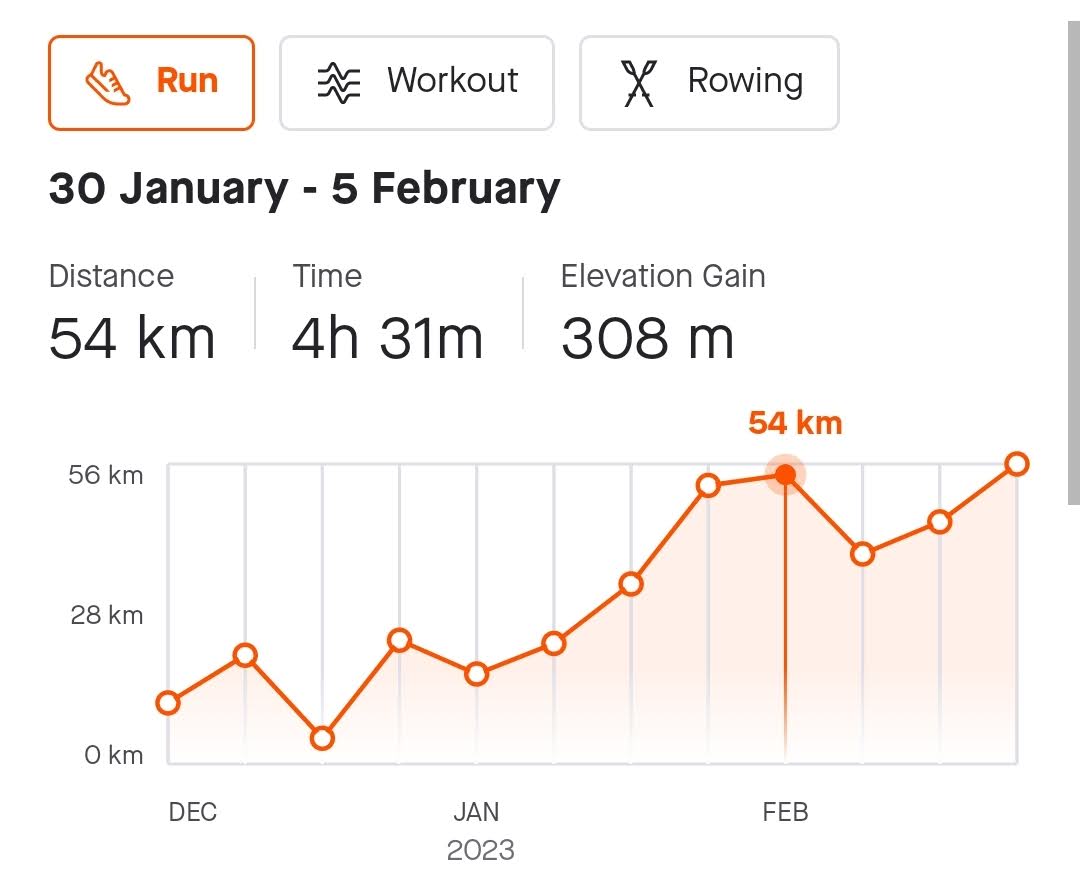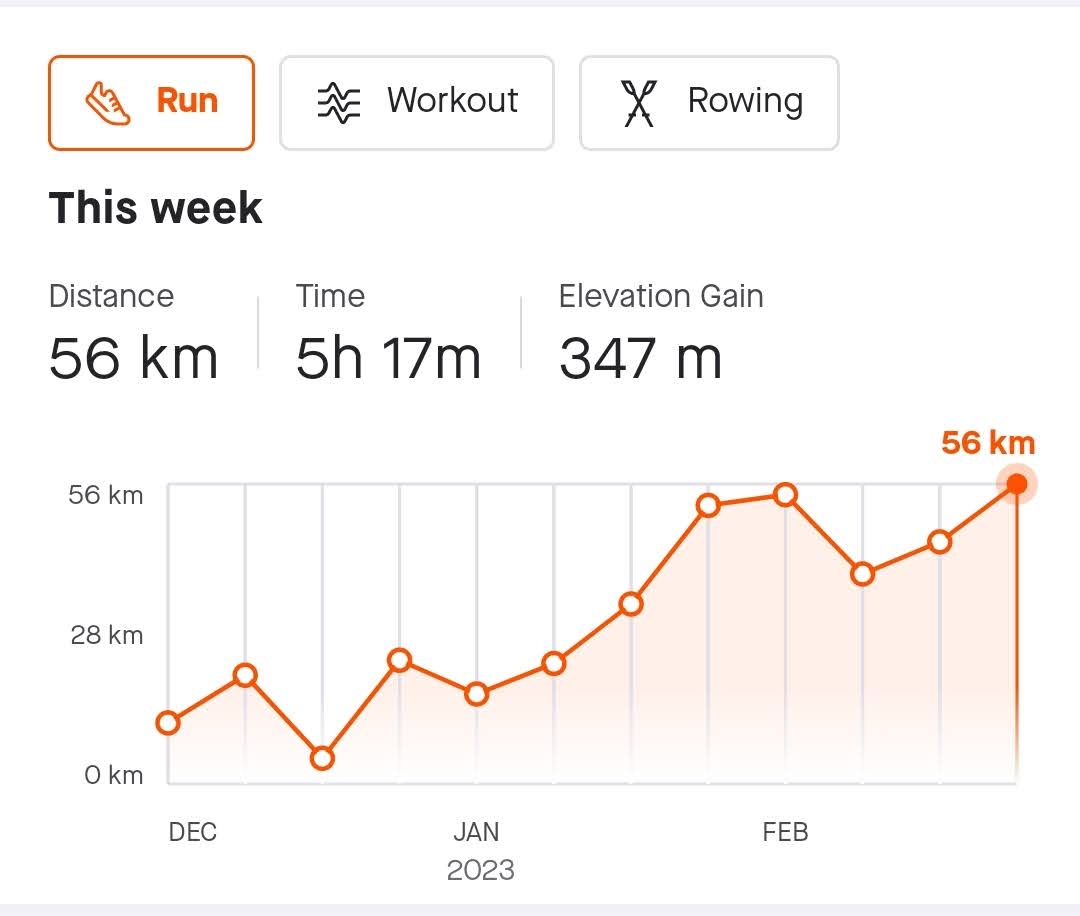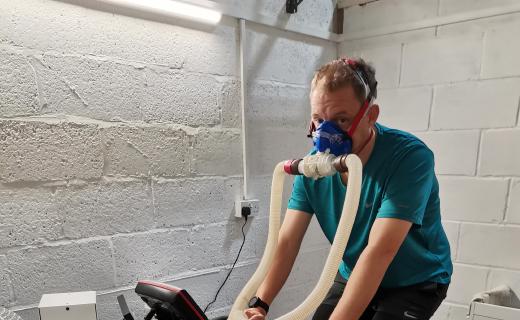Week 5: Training for the Manchester Marathon
Just 49 days to go.
Published February 26, 2023

Following on from last week’s blog, where I reported pain in my right knee during last Sunday’s long run, 16 km in, I have tried to think about what might have gone wrong and how to prevent it from worsening.
The pain began first in week 2, again around the 10-mile mark of a long run, but it didn’t come back for two weeks despite a half marathon race in between. So, what was different? Why was week three pain-free? Saving myself for a race, in week 3, I ran a little less overall, whereas, in week two and week 4, I was exclusively marathon training.
To help me understand, I looked at my running workload in the build-up to the knee pain using the Acute:Chronic Workload Ratio (ACWR) to calculate my risk of injury that week retrospectively. As you can see from the following result, I objectively overdid it in week 2.
Chronic workload = (16 km + 22 km + 33 km + 52 km) / 4
Chronic workload = 30.75 km
ACWR = Acute workload (week 5) / Chronic workload (average of weeks 1-4)
ACWR = 54 km / 30.75 km
ACWR = 1.76
Based on this calculation, my ACWR for that period was 1.76. This is an ACWR result above the recommended sweet spot of 0.8-1.3.

ACWR measures the relationship between recent (acute) and long-term (chronic) training loads. It is used in sports science and coaching to monitor and manage training load and reduce the risk of injury or overtraining.
The acute workload refers to the training volume or intensity over a recent period, typically the past week. The chronic workload refers to the average training volume or intensity over a more extended period, typically the previous four weeks. The ACWR is calculated by dividing the acute workload by the chronic workload.
An ACWR value between 0.8 and 1.3 is generally considered optimal, as it balances the need for adequate training stimulus with the need for recovery and adaptation. A value above 1.5 or below 0.5 may indicate a risk of injury or undertraining.
If you are interested in discovering more, the concept of ACWR was first introduced in a 2014 research article by Dr Tim Gabbett, a sports scientist and coach, titled “The Training-Injury Prevention Paradox: Should Athletes Be Training Smarter and Harder?”
So, using ACWR to prevent a worsening right knee while still hoping to train for my first marathon safely, I set myself a target workload of 45 - 55 km for the week. And here is my log.
Monday
To kick off the week, I went for an 8 km run to a nearby village. Although I heard some clicks from my knee, I didn’t experience any pain, which was a relief.
Tuesday
On Tuesday at noon, I took a sub-maximal VO2 Max test. I am still waiting for the results, but my absorption of oxygen has increased since my last test, but my tidal volume still needs some work. But I will wait for the results before further elaboration.
In the evening, I ran 8 km on the treadmill.
Wednesday
I participated in a Cardio Tennis session, which I always enjoy. Wearing my heart rate monitor, I recorded an average heart rate of 141 bpm and maxed at 177 bpm.
Thursday
It was a 1000-calorie cardio session comprising 3 x 10 minutes blocks at or above 144 bpm, followed by a 5 km run on the treadmill—all with a limited change over time.
Friday
I started the day with a 2-set match of tennis with my friend. I played much better than last week, and we ran out of time to play a tiebreak. In the evening, I ran 7 km on the treadmill at a comfortable pace. To my surprise, my everyday Nike Quest 5 shoes were comfortable to run in. I might promote them to my treadmill running shoes.
Saturday
Was another kids and parents Synergy 360 workout with Hanna. As the workout is for kids, it isn’t all that hard, but it was fun spending time with my daughter.
Sunday
It was a 27 km long run with an average pace of 6:12 /km. After the run, my average heart rate pleasantly surprised me. It was just 142 bpm and maxed at 163 bpm. That’s pretty good, as I was not trying to keep it low. However, I was trying to run well and keep my knee pain-free.
Unfortunately, at 18 km, my right knee did begin to hurt again. But not as much as it did last week. I also noticed it mainly only hurt when going uphill this time around. Also, in a 2 km section where I was off the road on a public footpath, running on grass, I got no pain at all.

With luck, the injury is not any worse, and as it did not hurt as much, it is hopefully a little better. Let’s look at the odds of this by calculating my week’s ACWR:
Chronic workload = (52 km + 54 km + 39 km + 45 km) / 4
Chronic workload = 47.5 km
ACWR = Acute workload (week 5) / Chronic workload (average of weeks 1-4)
ACWR = 56 km / 47.5 km
ACWR = 1.18
Based on this calculation, my ACWR for this week was 1.18, which is within the recommended sweet spot of 0.8-1.3. This suggests that the training load for the week was appropriate and should help to reduce the risk of injury (or, in my case, further injury), but importantly let me carry on training for the Manchester Marathon in 49 days.
Next week, I will aim for an ACWR around 0.9-1.1 to further allow my knee to heal, especially as I have a rehearsal 20-mile race on the 12th of March, and I need to turn up fit for it.


